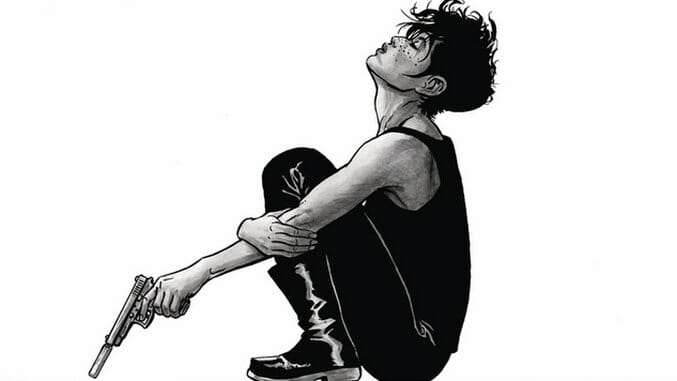
June is nearing its end, and with it go two major second acts: Greg Rucka’s return to Wonder Woman concludes this week with #25, and Lucifer’s second solo run wraps up. The former will continue next month under new management, but the latter is flying back into the void. Luckily, this final Wednesday of the month brings with it several notable debuts, including the winding Black Mask kickoff Beautiful Canvas, firebrand writer Alex De Campi’s latest, a totally rad Jem crossover, Valiant’s high-profile new team title and a crossover between the world’s greatest detective and a man who struggles with the delineation between rabbit season and duck season. If nothing hitting stands this week quite scratches your late-June itch, consider bidding adieu to Pride Month with some quality queer comics instead.
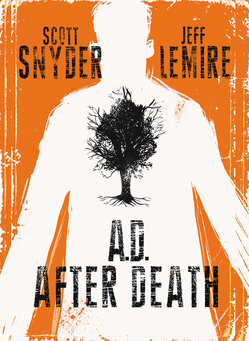 A.D. After Death HC
A.D. After Death HC
Writer: Scott Snyder
Artist: Jeff Lemire
Publisher: Image Comics
Current All Star Batman scribe and DC Comics architect Scott Snyder started his career teaching and writing prose, and it was lovely. His work was collected in the short story collection, Voodoo Heart, and while it lacked capes and fisticuffs, it exposed the writer’s obsessions of history, legacy and romanticized isolation; Paste’s first books editor, Charles McNair, called Snyder “a young writer who is simply too good to be overlooked for long.” McNair wrote the understatement of the century, though Snyder’s trajectory has veered far from his origins. The 10 years since Heart’s publication have witnessed Snyder’s ascent into comics royalty without a hint of his return to prose, save a looming novel called The Goodbye Suit. That absence makes a book like A.D. After Death all the more surprising and delightful. The project mixes Snyder’s fiction with spot illustrations from Jeff Lemire for roughly two-thirds of the work, with paneled sequential art rounding out the rest. The wordcraft borders on the sublime at moments; few writers can articulate music, color and melancholy with the economy and vividness displayed here. Snyder also embraces his recent predilection for pseudo-science, digging into pathology and ophthalmology to paint a world where a man refutes his immortality. Lemire’s soft watercolors contrast the story’s themes of fragility with their text of absolutism, and the resulting experience is both remarkably ambitious and heartbreaking. Sean Edgar
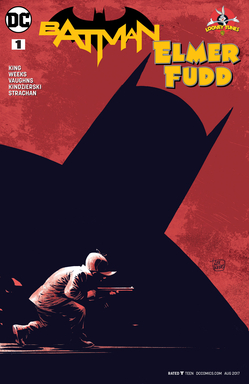 Batman/Elmer Fudd Special #
Batman/Elmer Fudd Special #
Writer: Tom King
Artists: Lee Weeks, Byron Vaughns
Publisher: DC Comics
The best mash-up of the year doesn’t come from audio chef Girl Talk, but from a gothic billionaire vigilante brawling with a bald cartoon sportsman. The only thing we can add to Jannon Calloway’s analysis is that this shit is crazy. Monthly Batman writer Tom King plunges both characters into a ‘40s noir playground where Fudd’s a hitman hunting down Bruce Wayne. A humanoid analogue of Porky runs a dive bar populated by a host of other Looney Tunes characters, all rendered by Lee Weeks with shadowy depravity. It’s the only media that will ever portray childhood icons as bottom-shelf-liquor-swilling lowlifes, and bless the Warner. Bros exec who said why not? The plot borrows the story structure of both superhero team-ups and classic noir, and works far more tightly than many other titles in this line. It wraps up when the jokes may have started to wear thin, yielding many laughs and making us ask why DC editorial isn’t taking more wrong turns at Albuquerque. Sean Edgar
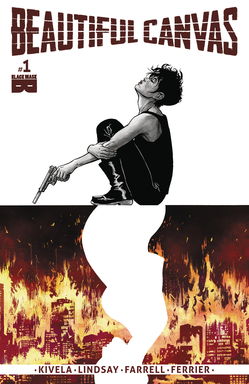 Beautiful Canvas #1
Beautiful Canvas #1
Writer: Ryan K. Lindsay
Artist: Sami Kivela
Publisher: Black Mask
Beautiful Canvas #1 is a wonderfully disorienting first issue: a hitwoman discovers her conscience when assigned to murder a child within days of finding out her own girlfriend is pregnant, an interesting-enough plot that soon adds human/animal hybrid assassins and the tease of much more combustible abilities on the way. Like We Can Never Go Home before it, Beautiful Canvas melds the classic comic-book complication of unusual abilities with the moral murkiness of real-world adult storytelling. Writer Ryan K. Lindsay plumbed similar depths alongside artist Owen Gieni with the award-winning Negative Space, an underwater-alien story about depression and suicidal thoughts. Lindsay and frequent collaborator Sami Kivela, who also teamed up on the sharp-toothed “surf noir” Chum, clearly have ambitions for this book beyond straightforward genre entertainment. Kivela has stepped up his skills with every project, and his work with colorist Triona Farrell on Beautiful Canvas shows off visual storytelling that places him in good company with fellow Black Mask surprises Tyler Boss and Eric Zawadzki. Steve Foxe
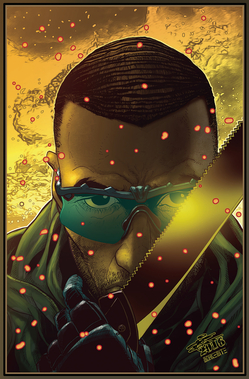 Bankshot #1
Bankshot #1
Writer: Alex De Campi
Artist: ChrisCross
Publisher: Dark Horse Comics
Alex De Campi is one of the first names to come up when people talk about weird, subversive, often-hilarious comics. Between Archie vs. Predator, Mayday and Ashes, De Campi has a well-earned reputation for violent, interesting titles that read much like grindhouse films (which, unsurprisingly, inspired her sci-fi/horror anthology, Grindhouse). This week, she starts a new series with artist ChrisCross that sounds like a thinking person’s summer blockbuster. The story revolves around a man with room for gray in his outward ethical stances; a man who, when confronted with his own secrets, is forced to adopt a persona that he’s only been play-acting up to that point. De Campi is an expert at walking the fine line between ridiculous and serious, and ChrisCross has a fun, sharp style that lends itself well to both slapstick and action. If their names aren’t enough to attract readers, the promise of punches and explosions definitely should be. Caitlin Rosberg
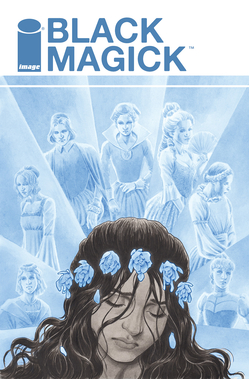 Black Magick #6
Black Magick #6
Writer: Greg Rucka
Artist: Nicola Scott
Publisher: Image Comics
Nothing good lasts forever, and in comics doubly so. Greg Rucka’s run on Wonder Woman is coming to a close this week, but, thankfully, the creator-owned project Rucka and collaborator Nicola Scott put on hold for their Wonder Woman work is here to smooth the transition. Black Magick is exactly the kind of project fans have come to expect and love from the writer: a sharp mystery filled with danger starring a driven, dark-haired woman who’s a little more brusque than her friends might prefer. The last issue came out over a year ago, and though it wrapped up the first arc, it ended with enough questions yet unanswered that readers were understandably concerned the book had been cancelled or abandoned. Readers following Rucka or Scott from Wonder Woman will hopefully enjoy this darker fare as detective (and secret witch) Rowan Black digs deeper into the mysteries that endanger her hometown. Caitlin Rosberg
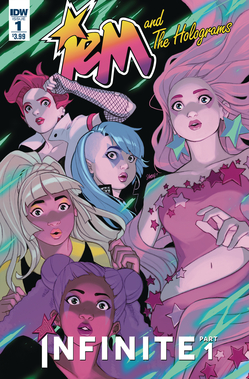 Jem & the Holograms Infinite #1
Jem & the Holograms Infinite #1
Writer: Kelly Thompson
Artist: Stacey Lee
Publisher: IDW Publishing
The improbable resurgence of ‘80s cartoon style icon Jem didn’t extend to the movie (does anyone else remember that it even existed??), but IDW’s comic iteration is still going strong under the guidance of writer Kelly Thompson and a rotating array of artists perfectly suited to the property’s neon aesthetic. Jem & The Holograms Infinite kicks off the franchise’s very first crossover event, and they’ve tapped Stacey Lee to draw the first chapter. Lee popped up a few times at Marvel, and it’s a synth-infused pleasure to see her back on interiors. The plot of this crossover builds on the interpersonal drama that’s been brewing in the pages of Jem and sister/rival title The Misfits, but the solicit makes it clear that Thompson and IDW are having a bit of self-aware fun with the concept of a Jem crossover event. The ongoing title doesn’t shy away from real conflict and emotion, but they’re not exactly fighting the Anti-Monitor. If you’re a Jem fan—new, old or lapsed—this is the big pyrotechnics number you’ve been waiting for. Steve Foxe
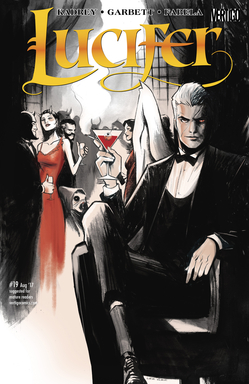 Lucifer #19
Lucifer #19
Writer: Richard Kadrey
Artist: Lee Garbett
Publisher: Vertigo/ DC Comics
Lucifer’s original run was one of the final entries in the golden age of Vertigo books, a legacy that started with Sandman and was brought into the current century on a bridge built by Preacher. In the 10 years since the former prince of Hell had a solo title, TV in particular has seen a slew of supernatural stories that leaned heavily on the mythos that Neil Gaiman had created and to which Carey and Peter Gross contributed, so Lucifer’s return to comics felt appropriate. Holly Black’s first 12 issues with artist Lee Garbett were sharp, smart and funny, and though they weren’t tonally the same as Carey and Gross’s work, they gracefully built on what came before. Richard Kadrey’s subsequent run with Garbett has been good, too, though it sometimes missed the essential elements of the female gaze that made Black’s run great. Fans coming in expecting to find Carey and Gross’ touch would be just as disappointed were they to watch the show, but those approaching the book with a love for the characters and celestial melodrama should enjoy the fun and the snark. With DC shifting the direction of its other blond supernatural charmer—from Constantine to The Hellblazer—Lucifer’s demise feels far too premature. Caitlin Rosberg
 Secret Weapons #1
Secret Weapons #1
Writer: Eric Heisserer
Artist: Raúl Allén
Publisher: Valiant
Arrival screenwriter Eric Heisserer shifts to sequential art this month with a story that pulls on various threads from Valiant’s dense superhero cosmos. The writer assembles an empathetic array of misfits with adorably lame powers, including the ability to chat with birds and make inanimate objects glow, tossing them in the trajectory of an alien cyborg who spouts magenta tendrils. Although this debut issue (of four) peeks into the comic publisher’s layered mythology, the script is jaunty and accessible, grounded in disarming humor. Characters Owen Cho and Nicole Finch are relatable, destined for a grand future they weren’t designed for and relinquished to the streets and minimum-wage jobs. (In other words, they’re every millennial with a bachelor’s degree.) Raúl Allén and Patricia Martin take a highly stylized, European approach, with a softer line and neon mood coloring that conjures ‘80s cyberpunk. It’s an endearing, visually thoughtful debut that hints at the directions Valiant’s looming film universe could pivot. Sean Edgar
 Star Wars: Droids Unplugged #1
Star Wars: Droids Unplugged #1
Writer/Artist: Chris Eliopoulos
Publisher: Marvel Comics
Unlike the surprisingly touching C-3PO one-shot comic, this issue is mostly made up of reprinted short comics from other Marvel Star Wars outings, with a two-page original addition from cartoonist Chris Eliopoulos. If you missed any of the issues in which these tales first ran (in the debut issues of Poe Dameron and Darth Maul, and the 25th issue of Star Wars), or if you’re looking for a handy, kid-appropriate Star Wars comic to hand to younger readers before IDW’s all-ages series kicks off later this year, Droids Unplugged is an excellent collection featuring the beeping, blinking, barely verbal favorites of a galaxy far, far away. Eliopoulos has long been one of Marvel’s go-to for kid-accessible comics, thanks to his knack for translating character and continuity into bright, fun storytelling. The addition of master colorist Jordie Bellaire to the mix elevates Eliopoulos’ style without sacrificing its youthful appeal. Steve Foxe
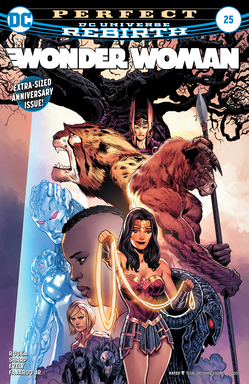 Wonder Woman #25
Wonder Woman #25
Writer: Greg Rucka
Artist: Bilquis Evely
Publisher: DC Comics
Writer Greg Rucka, gorgeously assisted by artists Nicola Scott, Liam Sharp and Bilquis Evely, performed something of a master-class rehabilitation on Diana of the Amazons, retrofitting (for the umpteenth time) her conflicting continuity into something accessible and—more importantly—appealing. It’s a shame but not a surprise that Brian Azzarello and Cliff Chiang’s Vertigo-esque re-imagination of Wonder Woman’s pantheon couldn’t survive the Rebirth shift intact, but Rucka and crew quickly assuaged doubts by putting many of Wonder Woman’s greatest foes and supporting characters back into play. With this oversized finale, Rucka caps off his second major run on the now-more-famous-than-ever hero. Wonder Woman’s future comic prospects seem more mixed: Super Hero Girls writer Shea Fontana will become one of the shockingly few women to write the core WW series when she starts her short run next issue, and will then pass the torch to Starman’s James Robinson and the rotating art team of Carlos Pagulayan and Emanuela Lupacchino. The optics of having another straight white male write the most visible female hero in the world aside, Robinson’s run will focus on…Wonder Woman’s brother and Darkseid’s daughter. Not exactly what fans of the film were clamoring to see. Celebrate Rucka and his collaborators one last time before we leap into a rockier period. Steve Foxe